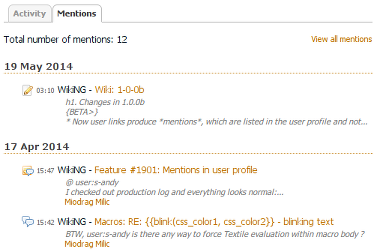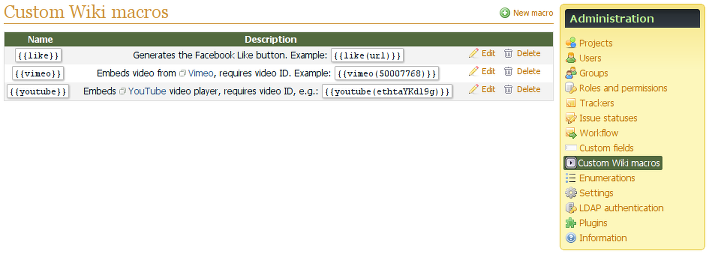 Breaking features in WikiNG 1.0.0b
Breaking features in WikiNG 1.0.0b
Let's be honest - WikiNG (were NG stands for Next Generation) was never too breaking - it was just a good name for the plugin... But 1.0.0b, I believe, changes this, as it comes with several breaking features and a lot of improvements...
User links are good, but what is the real effect of them? Why are they useful? Alright, they give the link to the user profile (which you should already know to be able to write the link), but, so what?.. When I was working on user links, I thought, that it would be great, if mentioned users were immediately notified about the mention... And that’s the first breaking feature, that comes with WikiNG 1.0.0b!

As soon as you write the Wiki rule for the user link and save the content, the notification gets sent to the mentioned user. In this email message the mentioned user can see the link to the Redmine object, in which you have mentioned him/her, so the user can react immediately just by following this link. And if you mentioned him/her in, e.g., an issue comment, the user can click the Quote icon and the user link to you profile will be automatically inserted into his/her response. So you will also be notified, when the mentioned user replies. If, however, you (or the mentioned user) disable email notifications, you will still be able to check all mentions under the new Mentions tab, that can be found in your public profile (for example check mine here or the image to the right)!
I guess you rarely use Redmine Wiki macros (that look like {{macro}})... I personally use native Redmine macros rarely. The concept of these macros was designed to let developers extend the Wiki syntax easily. But who needs this concept, if the more natural Textile-like syntax can be added instead (thus, I added {TODO} in WikiNG, and not {{todo}} macro)?.. This concept would, perhaps, work, if to utilize it you were not required to be a developer! Anyway, I’m going to check this, as WikiNG 1.0.0b comes with another breaking feature – the possibility to create custom Wiki macros using just the Redmine administrator web interface (Administration → Custom Wiki macros)!

With custom WikiNG macros you can configure, what HTML code should be rendered in place of the Wiki macro rule. As macros support arguments and content (see here) you can also use variables in the HTML code, which will be replaced with argument values (check details here). This, certainly, makes this feature extremely flexible. Thus, you can create macros for inserting YouTube videos, AdSense ads, styled text blocks and much more. Generally speaking, WikiNG custom macros can be used to replicate most of the standard Textile rules and even most of the WikiNG Textile extensions. But the best things is that with this feature you can easily create your own specific and (possibly) much needed Wiki syntax extensions, that would unlikely be developed by someone in a plugin!
If you have used the native Redmine footnote syntax, you probably have noticed issues related to its usage... Thus, when you need to update a Wiki content and to add a footnote to it, you also need to increase all subsequent footnote numbers! I believe, that it’s wrong as these numbers should be generated dynamically... And that’s one more feature, that comes with WikiNG 1.0.0b!
New WikiNG footnote syntax resembles the one of DokuWiki (and, perhaps, of many other Wiki systems) – you just need to put your footnote inline into double parentheses1 and WikiNG will automatically generate the index number for it! Besides the inline position of the footnote code in the text helps keeping the context and understanding its meaning.
Among other interesting features in WikiNG 1.0.0b are:
- Support for smart quotes → for example, check “this text”.
- Support for format in user links → thus,
user[f]#1gives th first name: Andriy. - New icons
(v)and(x)→ and . - New
{BETA}marker → - And others.
Why beta?¶
No, not just to demonstrate the new marker! Support of mentions required a lot of changes, smart quotes can do a lot of mess (and their previous revision, actually, used to) etc – all these makes me think, that bugs are possible, while I’m not aware of any...
1 with no space before it
Comments